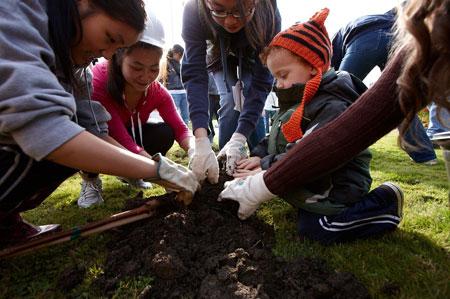By Michelle Werts

Of all of the issues we tackle here at American Forests, an urban forest is one of the gnarliest to comprehend. I mean, the very name seems to contradict itself: How can you have a forest in an urban area — at least one not of the concrete variety? But “forests” do exist in cities, towns and communities across the country. They just don’t always resemble the idyllic, rural forests and landscapes made famous by painters and photographers. Instead, these forests are comprised of that tree in the median, the plants in your front yard, the river that cuts through the city, the parkland where the children play. It consists of all of those nature elements you come across in the city every day — the ones you may not even register.
And while they may be easy to overlook on a daily basis, these forests can only exist with a helping hand, which is what Urban Forests Case Studies celebrates. It acknowledges the men, women, governments and organizations who have stepped up to make sure that their urban forest is working for all of the people who rely on it because urban forests do so much for us on a daily basis:
-

Planting trees at a Sacramento Tree Foundation event. Credit: Sacramento Tree Foundation Studies have shown that every $1 invested in urban trees results in $2 to $4 in benefits, including lowered energy costs, reduced stormwater flows, improved aesthetics, higher air quality and reduced carbon dioxide concentrations.
- Urban trees in the lower 48 states store 770 million tons of carbon, valued at $14.3 billion, and remove approximately 784,000 tons of air pollution annually, with a value of $3.8 billion.
- A single front-yard tree can intercept 760 gallons of rainwater in its crown, reducing runoff and flooding on your property.
- Public housing residents with nearby trees and natural landscapes reported 25 percent fewer acts of domestic aggression and violence.
- Tall, dense trees with soft ground surfaces can reduce noise by 50 percent or more.
With more and more people moving into cities — experts estimate that urban land in the lower U.S. will increase by 8.1 percent by 2050, a land mass larger than the state of Montana — urban forests are going to be more important than ever in the future, which is why earlier this year, American Forests launched its Community ReLeaf program with partner Bank of America Charitable Foundation. Taking into account things we learned through our research for Urban Forests Case Studies, this program is working with cities across the country to measure the impact of their urban forests and figure out how and where the urban forests can be bolstered to provide more services to urban residents.

Now, before I sign off for today, I need to take a moment to thank those crucial for making the book and, thus, this award happen. First, the U.S. Forest Service’s Urban & Community Forestry Program, who has been an unfailing partner to the American Forests Urban Forests Program over the last few years and whose grant made our award-winning Urban Forests Case Studies possible. Second, all of the individuals in the 12 cities who selflessly gave their time and expertise to this book. They are the ones working in urban forests every day, fighting the good fight to keep them healthy and working for us. As this book and award wouldn’t exist without the U.S. Forest Service and the local urban forest practitioners we are pleased and excited to share this award with them.